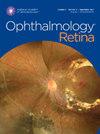Intra-arterial Chemotherapy for Retinoblastoma, Outcomes Analysis in 357 Eyes
IF 5.7
Q1 OPHTHALMOLOGY
引用次数: 0
Abstract
Objective
To evaluate the outcomes of intra-arterial chemotherapy (IAC) for the treatment of naive and nonnaive retinoblastoma eyes. Ocular survival rates, risk factors for enucleation, ocular complications, metastatic disease, and overall survival were analyzed.
Design
A retrospective, single-institution study.
Participants
A total of 300 patients treated with IAC between April 2010 and April 2023 were included.
Interventions
During IAC infusions, 1 to 3 drugs were used (melphalan, 3.0–7.5 mg; topotecan, 0.3–2.0 mg; and carboplatin, 20–50 mg). Adjuvant therapy was used as needed to consolidate treatment.
Main Outcome Measures
Ocular survival rates, ocular complications, and the risk factors for enucleation were measured.
Results
A total of 357 eyes were treated with 1536 IAC infusions, with a median of 4 cycles per eye, and followed for 60.69 months. The Kaplan–Meier estimates for the overall ocular survival were 90% at 1 year, 89% at 2 years, and 86% at 5 years. No difference in ocular survival was found between IAC indications (primary 88% vs. secondary 85% vs. bridge 89%; P = 0.52) and the use of tandem therapy (tandem 85% vs. no tandem 87%; P = 0.93). Intravitreal chemotherapy was used as adjuvant therapy in 31.37% and plaque therapy in 5% of the eyes. The group did not receive external beam radiation. Univariable and multivariable analyses showed that the presence of subretinal seeds was significantly associated with an increased risk of enucleation, and the use of ophthalmic artery (OA) ostium in >50% of infusions per eye was a protective factor to avoid enucleation. Retinal and choroidal vascular, ischemic, or atrophic effects were the most frequent complications found in 5.0% of the eyes. Metastatic disease was observed in 0.33% of the patients. The overall 5-year patient survival was 99.3%.
Conclusions
The use of IAC in different indications (primary, secondary, bridge, and tandem) to treat naive or recurrent–refractory retinoblastomas showed successful results. Most eyes were preserved. Subretinal seeds at presentation were associated with a high enucleation risk. The use of the OA ostium for drug delivery avoided enucleation.
Financial Disclosure(s)
Proprietary or commercial disclosure may be found in the Footnotes and Disclosures at the end of this article.
动脉内化疗治疗视网膜母细胞瘤,357只眼睛的结果分析:巴西转诊中心13年的经验
目的:评价动脉内化疗(IAC)治疗初发性和非初发性视网膜母细胞瘤的疗效。我们分析了眼部存活率、眼球摘除术的危险因素、眼部并发症、转移性疾病和总生存率。设计:一项回顾性、单机构研究。参与者:2010年4月至2023年4月期间共纳入300例IAC患者。干预措施:在IAC输注过程中,使用1-3种药物(美法兰,3.0-7.5mg;拓扑替康,0.3-2.0 mg;卡铂,20-50毫克)。根据需要进行辅助治疗以巩固治疗。主要观察指标:观察眼部存活率、眼部并发症和眼球摘除术的危险因素。结果:共357只眼接受了1536次IAC输注,平均每眼4个周期,随访60.69个月。Kaplan-Meier估计,1年总眼生存率为90%,2年为89%,5年为86%。IAC适应症间的眼生存无差异(原发性88% vs继发性85% vs过桥89%;P = 0.52)或使用串联治疗(串联85% vs不串联87%;P = 0.93)。玻璃体内化疗辅助治疗占31.37%,斑块治疗占5%。这组患者没有接受外部束辐射。单变量和多变量分析显示,视网膜下种子的存在与眼球去核的风险增加显著相关,使用眼动脉(OA)口(每只眼睛输注50%)是避免眼球去核的保护因素。视网膜和/或脉络膜血管、缺血或萎缩是5.0%的眼睛最常见的并发症。0.33%的患者出现转移性疾病。总体5年生存率为99.3%。结论:IAC在不同适应症(原发性、继发性、桥接性和连续性)中治疗初发或复发难治性视网膜母细胞瘤取得了成功的结果。大部分眼睛都被保存了下来。视网膜下种子的出现与高的去核风险相关。使用OA口给药可避免眼球摘除术。
本文章由计算机程序翻译,如有差异,请以英文原文为准。
求助全文
约1分钟内获得全文
求助全文

 求助内容:
求助内容: 应助结果提醒方式:
应助结果提醒方式:


